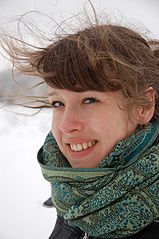Beauty retouch
As Beautyretusche is called photo manipulation with the goal of reflecting human faces and bodies in accordance with a beauty ideal . In contrast to retouching , beauty retouching is not primarily about eliminating image defects. Beauty retouching is mostly used in the field of advertising and glamor and fashion photography .
Differentiation from classic photo retouching
Normal portrait retouching is about improving a photo (retouching dark circles, removing blemishes).
In the case of beauty retouching, on the other hand, the photo only serves as raw material. This raw material is manipulated until it corresponds to a (flawless) ideal . This ideal image usually expresses conspicuous key stimuli or serves commercial marketing strategies (see also applications).
In the English-speaking world, the term virtual makeover is used - although the word makeover is also used in connection with surgery , car tuning and cosmetics .
aims
- Example of a beauty retouch:
The aim of beauty retouching is usually to make a face appear as flawless as possible. The following methods are used for this:
- Removal of blemishes or details such as birthmarks and hair
- Elimination of wrinkles and skin tightening and smoothing
- Elimination of asymmetry
- Teeth whitening
- Change of proportions
- Reduction of excess weight and emphasis on attractive elements
- Sharpening of the eyes, brightening of the iris to create a "piercing look"
From a technical point of view, beauty retouching changes the surface structure and sometimes the biometric dimensions of portraits.
Applications
Fashion , advertising and the rainbow press are the most common uses for beauty retouching. There is almost no published portrait photo without a beauty retouch. Individual portrait photographers also offer this type of manipulation . Beauty retouching is used primarily to optimize sales in all fields of application .
External features that are considered attractive in the statistical average taste ( mainstream ) (see also study by the University of Regensburg) serve as a matrix for the ideal. This matrix is linked to the desired products and services (magazine sales , retort tapes , car advertising, ...) in order to ensure higher sales figures.
automation
Three reasons led to the development of automated beauty retouching:
- The precise definition of the statistical average taste ("Western ideal of beauty ").
- A high market need to satisfy this mainstream ideal.
- The high technical standard in electronic image processing .
criticism
A portrait manipulated by beauty retouching is an art product, but it cannot be recognized as such. Due to the dominance in the mass media, this art product has become an (unrealizable) ideal of beauty.
literature
- Meike Jarsetz: The Photoshop book for digital photography . Galileo Press Edition Page, Bonn 2009, ISBN 978-3-8362-1244-1
- Meike Jarsetz: The Photoshop book People & Portrait: Current on Photoshop CS5: Current on Photoshop CS5. From basic retouching to complete body styling - including beauty and glamor retouching . 1st edition. Galileo Press, 2011, ISBN 978-3-8362-1710-1
- Pina Lewandowsky, Katharina Sckommodau: Adobe Photoshop CS4 - Practice for professionals: Effects, montages, image corrections . Addison-Wesley, 2009, ISBN 978-3-8273-2792-5
- Bianca Schmidt: Beauty photography digital and analog: Professional workshop . Verlag Photographie, 2006, ISBN 978-3-933131-82-9
- Barbara Davatz: Beauty lies within: portraits from a globalized fashion world . Limmat Verlag, 2007, ISBN 978-3-85791-530-7
- Christian Haasz, Stefan Weis: Beauty retouching with Photoshop . Franzis, 2010, ISBN 978-3-645-60038-5
Web links
- Beauty retouching on Youtube
Individual evidence
- ↑ Study by the University of Regensburg
- ↑ Johannes Korge: Ban on Roberts advertising. You are too pretty woman. Der Spiegel , July 28, 2011

